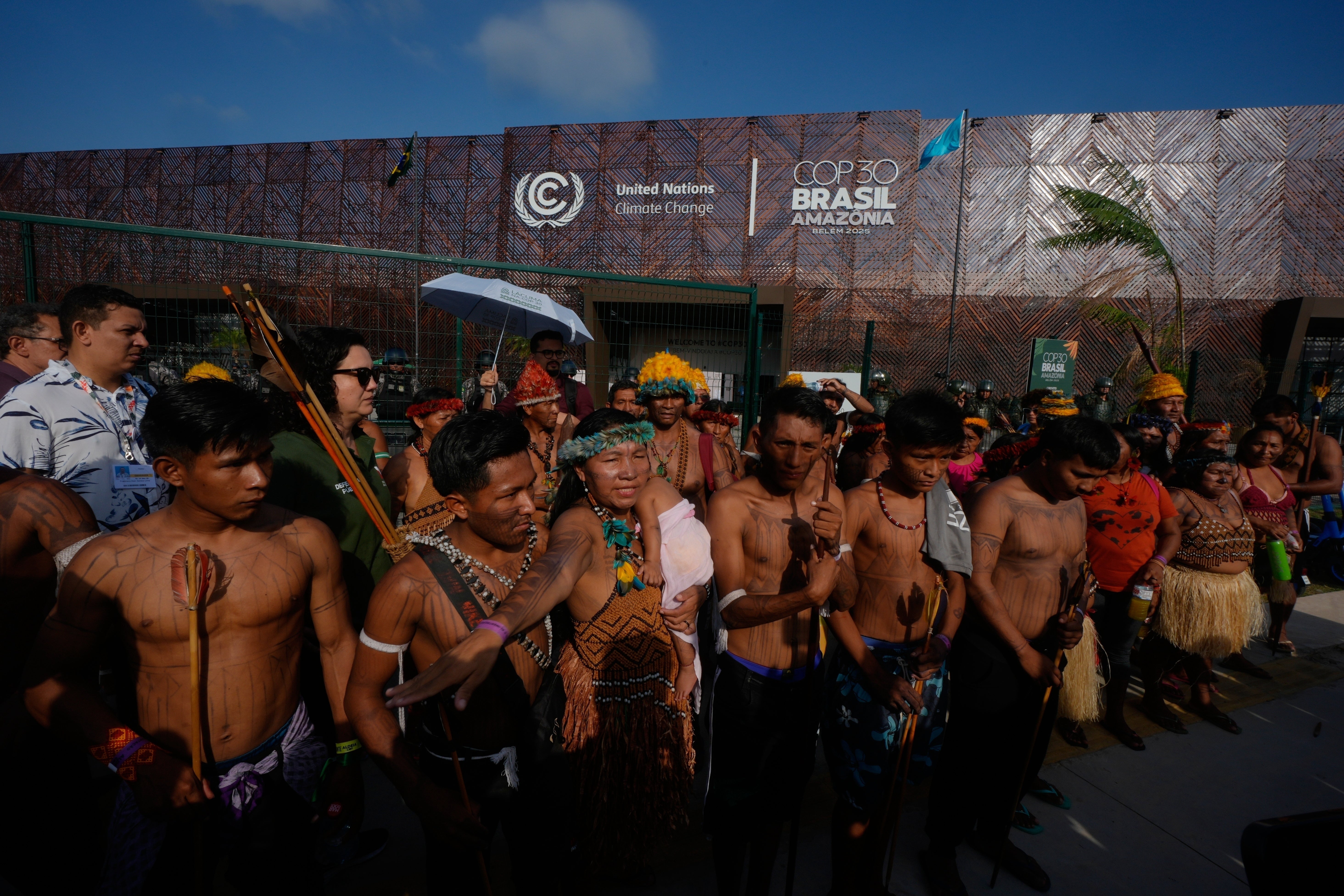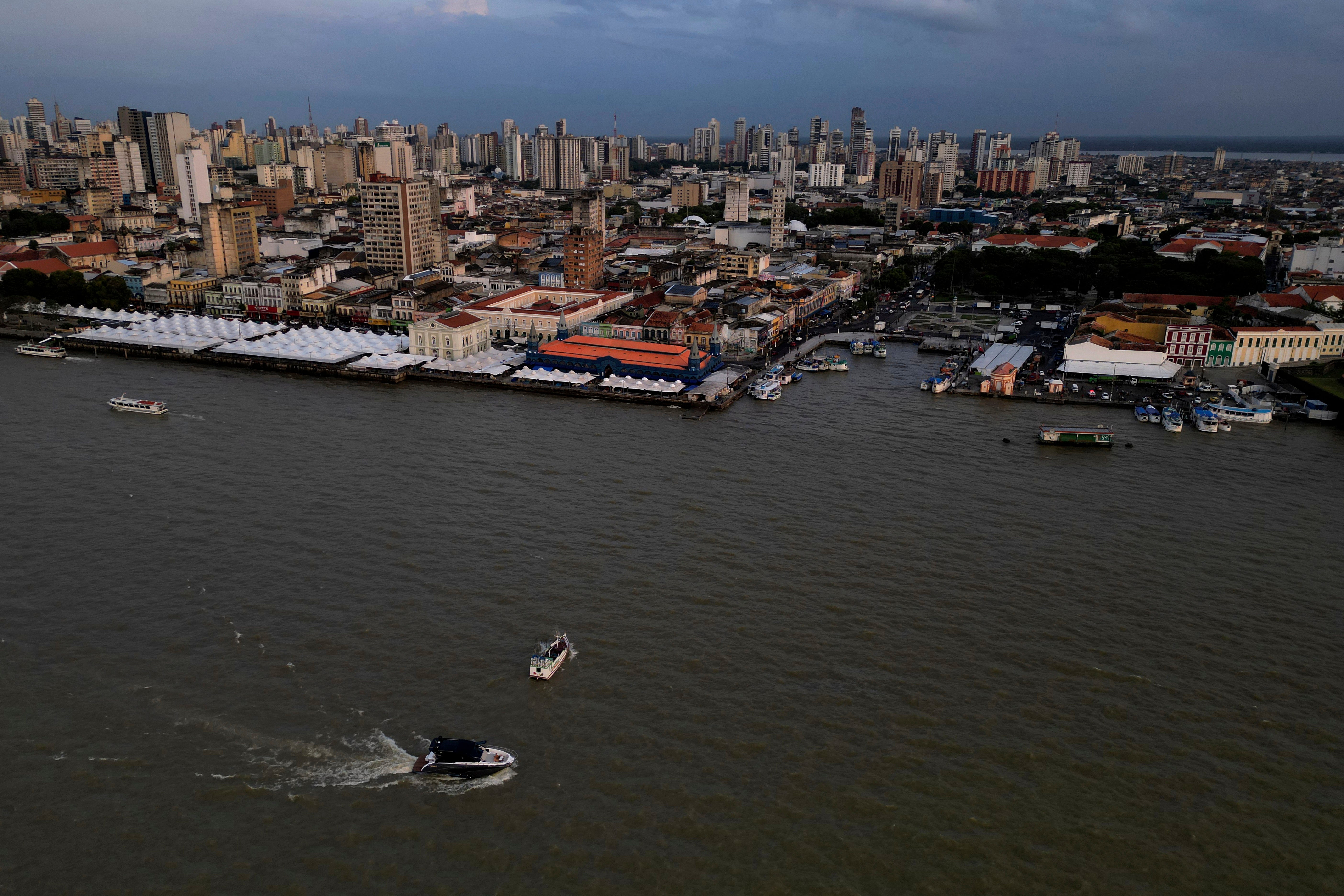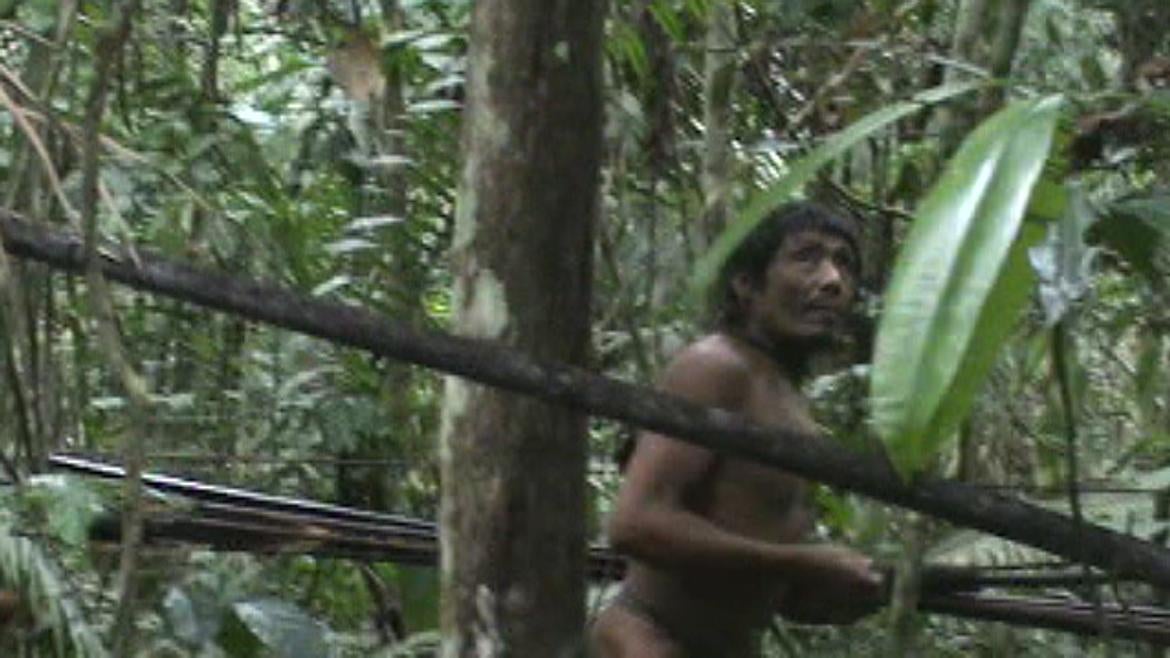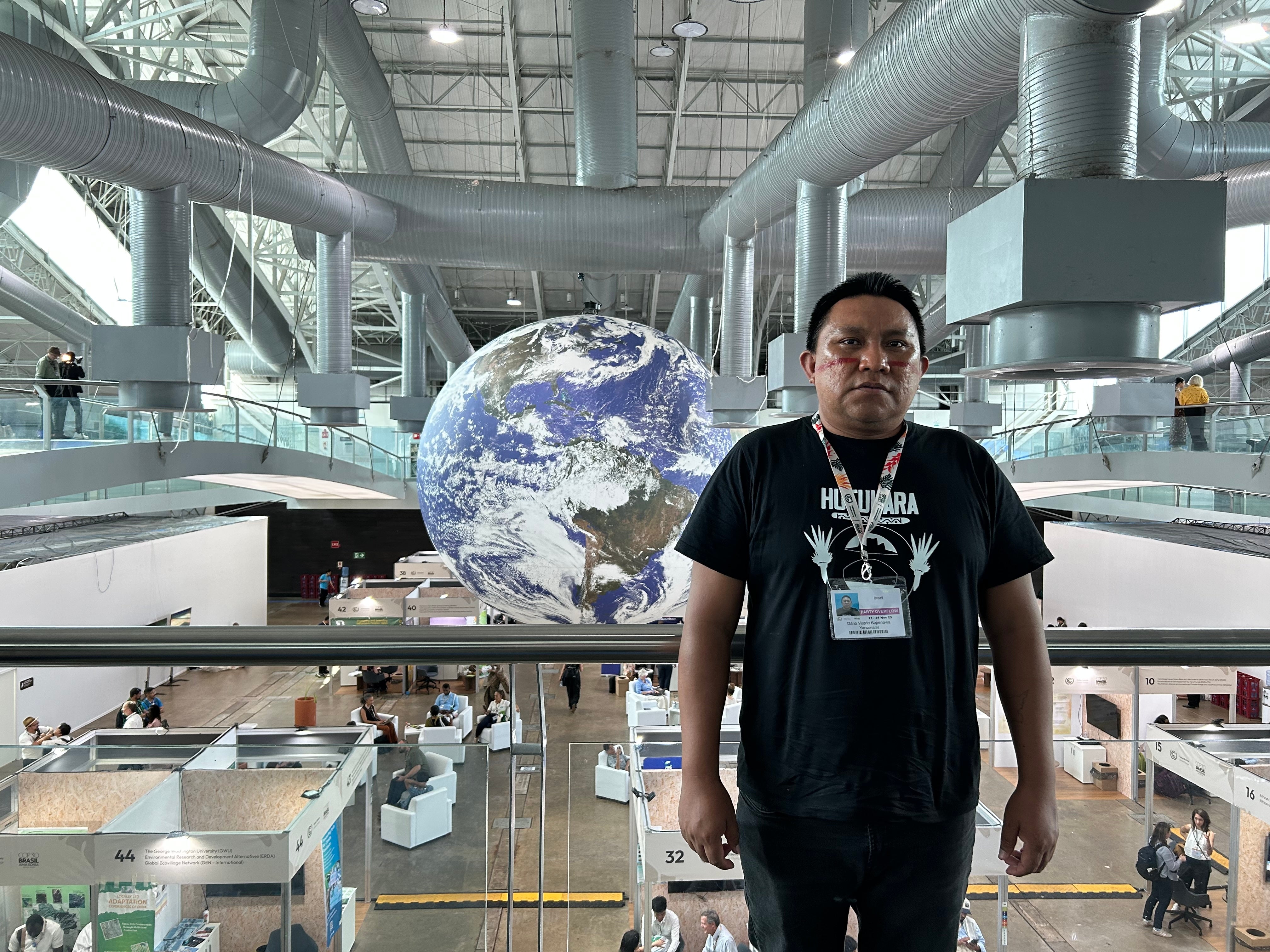Arriving at the Cop30 climate conference in Belém, the gateway city to the Amazon, each of the 50,000 delegates is given a reusable metal water bottle printed with the cartoon of a flame-haired, spear-wielding figure known as “Curupira”.
Curupira is a spiritual figure from Amazonian folklore, who is considered a guardian of the rainforest and its animal inhabitants. According to the Brazilian Cop presidency, the mascot reflects the commitment to cut emissions and make protection of the forest a key ambition.
When asked what he thinks about such iconography, Dário Kopenawa Yanomami – an indigenous leader from deep in the Amazon, close to the border with Venezuela – only smiles. “It’s just propaganda. And we have to go beyond propaganda,” he says.
Dário’s community is suffering from threats including illegal logging and land clearances, but the most pressing problem is illegal mining invasions from prospective gold miners. “They cut down the trees, they flood the river with mercury, and they give alcohol and guns to other members of the community to try and turn us against each other,” he says, adding that while things became “really bad” under the right wing populist President Bolsonaro, who was in power between 2019 and 2023, they have yet to notably improve under the current progressive President Lula.
While deforestation has been falling since Lula was elected, falling 30.6 per cent between August 2023 to July 2024 period, Lula stoked significant controversy by pushing for oil exploration in the Amazon region in the weeks leading up to Cop30.
A big Brazilian push for carbon offsetting projects at Cop30, which it is hoped will lead to more “credits” being sold based on the carbon absorbed by trees, has also been unpopular among indigenous peoples. “How can you put a price on something that nature give us for free… the air, the water, the sun, and the trees are not things that should be sold for profit,” says Taily Terena, an indigenous activist hailing from the Pantanal in southern Brazil, which is the world’s biggest wetland area.

On Friday, the entrance to Cop30 was blocked for around 90 minutes by around 100 members of the Munduruku people, with leaders sharing a set of demands that included the canceling a grain railway project, an end to commercial development of rivers, and the cancelling of carbon market projects.
Both Taily and Dário express concerns around Brazil’s flagship forest protection project the Tropical Forest Forever Facility (TFFF), which is intended to incentivise forest nations like Brazil to prevent deforestation, by essentially setting up a massive investment fund to give annual payments to countries to aid their forest conservation efforts. “It doesn’t really seem to be for indigenous people, it seems more a plan for white people to have the forest,” says Dário – despite the fact that some 20 per cent of the funds are promised for indigenous people.
“While the TFFF acknowledges the role of traditional peoples, it remains part of the financialisation of nature – a model that has failed to stop deforestation or protect communities, and instead prioritises profit,” adds Eduardo Raguse, an activist at Amigas da Terra Brasil.
A forest community in the shadow of Belém
The location of Cop30 in Belém means that you do not have to go far to find evidence of the rainforest being destroyed.
A few minutes boat ride from the city lies the home of Seu Ladi, an 83-year-old forest-dweller of indigenous and Afro-Brazilian descent, who met with The Independent just ahead of the Cop30 climate talks beginning.

Ladi has lived off the same small patch of land in the forest his entire life, growing native plants like açai and cacao, while also harvesting all manner of other herbs, flowers, resins and other products that grow in the forest, the knowledge of which he keenly shows off during a walk deep into the forest. His is a way of life that has remained largely the same for generations – which is not something that can be said for the city of Belém and its residents.
“When I was younger, Belém was all forest, and the port was a beach,” he says. “We used to paddle there at 2am in the rain to sell herbs at the market,” he explains. These days, huge swathes of the forest in the area have been chopped down, he says - a phenomenon which, along with the escalating climate crisis, has transformed formerly reliable weather patterns.
“Nowadays it becomes too hot at times and there is not enough rain,” Ladi explains. “At other times, there is far too much rain, and the storms become so great that I worry the city is going to wash away.” The weather patterns mean that certain products have become harder to find in the forest, including Brazil nuts, which Ladi searches in vain to find for The Independent.



Teams of loggers continue to come to the area, searching for expensive hardwoods that fetch a high price on the black market. “Recently they came and I became so angry, I wanted to take my hunting gun and shoot them right away,” he says. “I pray to God for them to stop, and I do believe that God will ensure these people will one day pay.”
As for Cop30, Ladi says that the priority should not be about schemes to bring money to the rainforest, but should instead be about boosting the rights of the people that live there.
‘One thing we don’t need here in the forest is money… We live in the Amazon, we have all the wealth we could possibly need,” he says. “What we need is protection, and for the forest to be preserved from more destruction.”
Away from Belém, among Brazil’s more than 100 uncontacted tribes, that question of protection becomes a matter of life or death.
Such groups include the Awá people, who live just 200 miles from Belém in the same state of Para, who are at great risk as loggers, ranchers and settlers invade their territory, according to Sarah Shenker, from the London-based NGO Survival International. There are approximately only around 350 Awá people left on Earth.
Elsewhere, in the neighbouring state of Mato Grosso, lies the indigenous territory of the Kawahiva, an uncontacted tribe of nomadic hunter-gatherers that are similarly under threat from land grabbers, loggers and cattle ranchers. What’s more, in the face of intense lobbying from external interests, the territory has yet to undergo the process of “demarcation”, which is when the government guarantees the tribe’s legal right to their land.
“At the beginning of this year, the government promised that the demarcation would be done by the end of this year, but that's clearly not going to happen because we were already in November,” explains Shenker. Ongoing work to pave a road that lies just 3km from the Kawahiva’s territory is set to increase threats to the tribe yet further.
The Brazilian agency for indigenous rights, Funai, was contacted by The Independent about these claims.
It is believed that around half of the 196 uncontacted Indigenous groups living in 10 countries across the world are currently facing extinction, according to a five-year study from Survival International released ahead of Cop30, due to threats including logging, mining, agribusiness, criminal gangs, and the spread of diseases.


Protecting indigenous communities is also not only about human rights, but also about protecting the forest itself. An estimated 36 per cent of the world’s remaining intact forest lies in indigenous peoples’ lands – and studies show that when indigenous land rights are legally recognised in Brazil, there is typically a 66 per cent decrease in deforestation within the land’s borders than in neighbouring non-indigenous lands.
Back at Cop30, when asked by The Independent if he worries for the future of his people given the ongoing threats from miners, Dário Kopenawa Yanomami is unequivocal: the threat to indigenous people threatens us all, not just the Yanomami people. After all, he continues, indigenous people are the most successful guardians of rainforest environments that play such a crucial role in oxygenating the atmosphere, and regulating the rainfall patterns that secure our food systems.
“Western people have to stop thinking that the Amazon is only for an empty forest. We indigenous people are there and protecting the forest,” he says.
“Supporting us is not only about protecting forest indigenous people, but about protecting everybody. If there is no future for indigenous people, there is no future for anybody.”
This article was produced as part of The Independent’s Rethinking Global Aid project
The UK used to be a world leader on climate – does it still count?
Thousands march in Glasgow for ‘biggest climate rally since Cop26’
China basks in the spotlight at Cop30 as Trump forces the US to stay away
Cop30 climate talks in Brazil see record presence of fossil fuel lobbyists
UK’s failure to back sustainable mackerel fishing condemned as ‘pitiful’
Ancient rock formations could store millions of tonnes of CO2, research says







